Skilhunt M150 flashlight review
- Skilhunt M150 intro
- Build quality
- LED, Lens Bezel and Reflector
- Dimensions and weight
- User interface
- Batteries and charging
- Performance
- Conclusion
- Skilhunt M150 for sale
Introduction:
In this review, we will test the Skilhunt M150, which is an AA sized EDC light that operates on a single 14500/AA/NiMh cell withan electronic side switch.
The Skilhunt M150 is a small light with an output of up to 750 Lumens and with a magnetic charging port.
It comes with a Skilhunt 14500 rechargeable Lithium-ion cell so no need to buy any accessories, it will come complete and ready-to-go. This is a very complete light and looks and feels like a premium flashlight. This is due to all the attention to detail.
For all tint snobs out there, you will probably already have noticed this light is equipped with a Cree XPL2 emitter, so all prejudices are true.
Packaging The light arrived in a beautiful color printed cardboard box with a black plastic holder,
After opening the box, you will find a plain white vacuum-formed plastic inner tray that holds the light, together with a yellow cardboard box with the Skilhunt logo printed on it. All accessories are packed in the yellow cardboard box.
What you’ll get:
- flashlight
- clip
- 2 spare O-rings
- 800 mAh Skilhunt 14500 cell
- lanyard
- Magnetic charging cable (With USB A connection)
- Manual
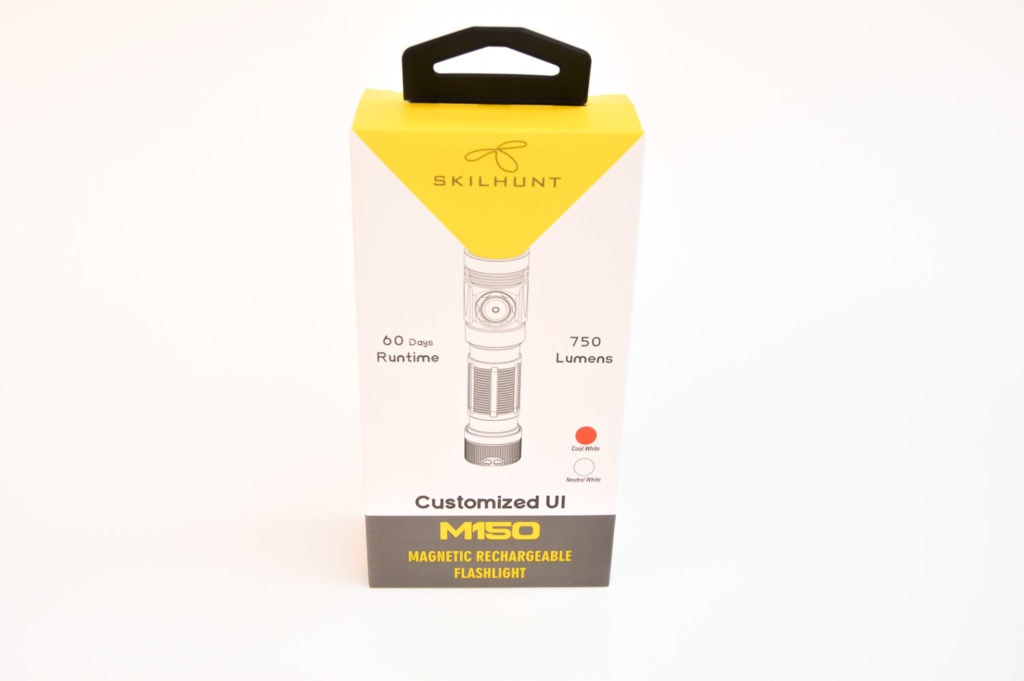
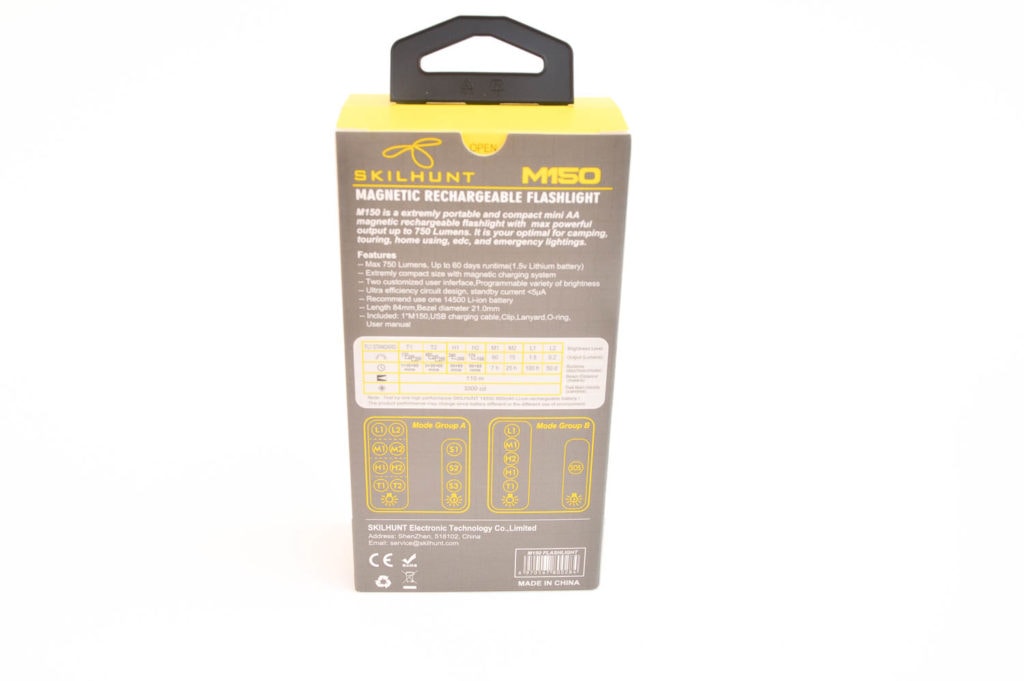
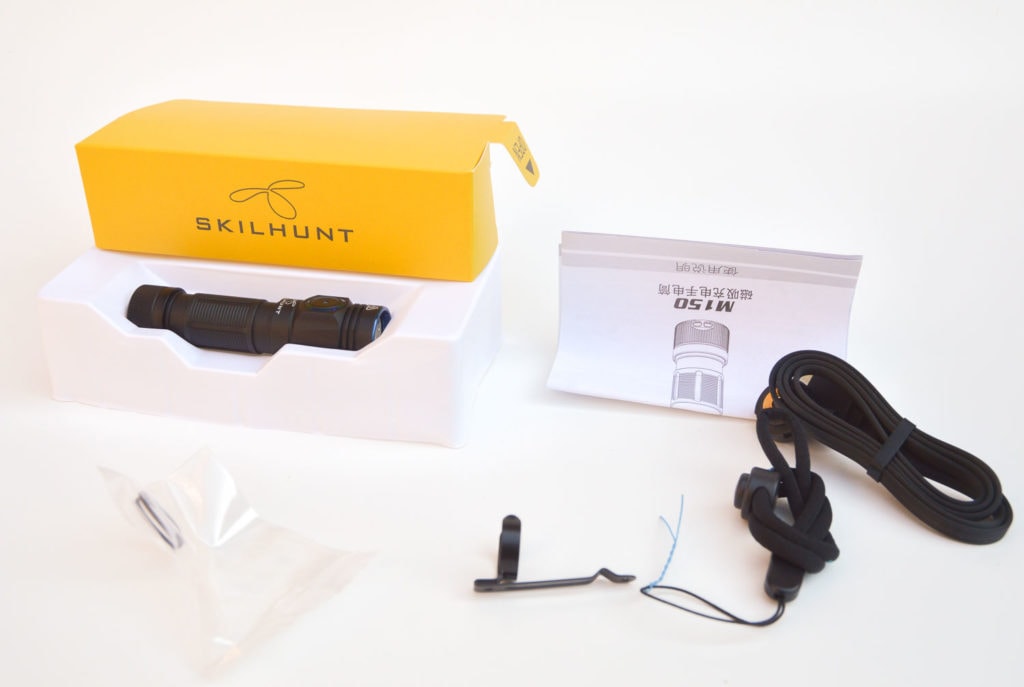
| LED | Cree XPL2 HD Cool White |
| Lumens | Max 750 Lm |
| Beam intensity | 3000 Cd |
| Battery config. | 1 x 14500, 1x AA, 1xNiMh |
| Material | Aluminium |
| Modes | 4 modes (with 4 sub-modes) |
| Blinkies | Yes, three strobe modes |
| Reflector | Orange peel reflector |
| Waterproof | 2m submersible (IPx8) |
| Review date | september 2019 |
Handling of the light and knurling
Handling of the light is as expected, very good, due to its small size. I personally like this size a lot since it is just about the max size for an Everyday Carrying (EDC) flashlight. The size is like any regular AA or 14500 type flashlight.
The Skilhunt M150 provides more than enough grip. There are small rings and a lengthwise cutout on the light which improves grip. Also due to the position of the sideswitch, it is very easy to operate with the e-switch. When holding the M150, I intuitively place my thumb on the sideswitch, which feels very familiar and makes it easy to operate.
The tailcap is fitted with a magnet, which is a neat feature, the magnet is strong enough to keep the light hanging upside down on a steel screw, and therfore useful for many applications.
Since the tail has a flat surface, it tail-stands very well, and hanging it to any flat metal surface is no problem. (why doesn’t every manufacturer use magnets in their tailcap when possible?)
Since this is a traditional reflector shaped flashlight, the beam is as expected, it gives a traditional hotspot with a spill, also called corona.
To carry the Skilhunt M150 in your pocket, it comes with a pocket clip that feels very sturdy. I was afraid to damage the light when taking the clip off, but the anodizing is strong, so it left no marks or scratches. The clip is just barely long enough, I would have preferred a longer one, but due to the shape of the flashlight, it doesn’t allow for a longer clip.
A lanyard is also included, and this is one of the more luxurious types, not a flimsy cheap cord type, but a braided one with the skilhunt brand on it and the adjustable plastic button.
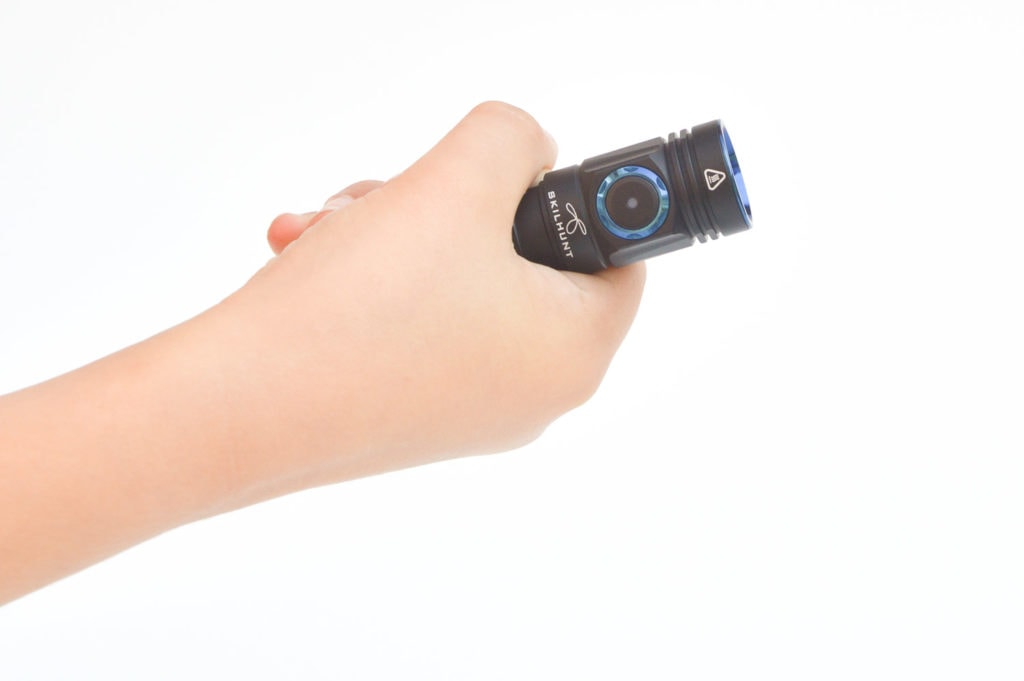
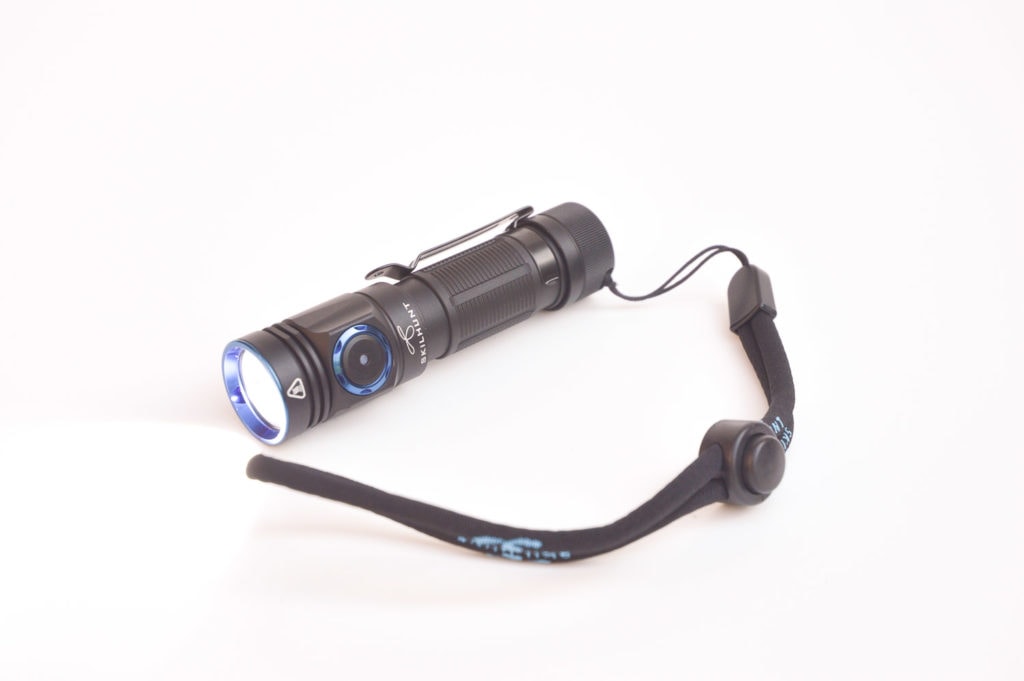
Build Quality, threads, o-rings and anodization
The anodizing on the Skilhun M150 is good, as I said earlier, removing the clip from the body doesn’t leave any scratches or marks. The anodization feels very good and provides enough grip since it is more the matte type anodizing.
Rubber O-rings of the light can be found below the glass lens and on both ends of the body tube. The body tube does not separate easily from the head, because the head seems to be glued to the body. Well, that was a nice challenge for me, so I clamped the light in a vice (with proper protection against scratches) and I was able to open it with a pipe wrench. Can you see red threadlocker in the pictures?
The threads are square-cut and came lubed. The tailcap screws on very easily. I’ve handed over 35+ flashlights by now, and each brand is different. One of the ways to ‘measure’ the quality of a flashlight is usually by seeing how well all the flashlight parts fit together, as well as the way they screw onto each other. This is different for every light, and the M150 looks and feels great.
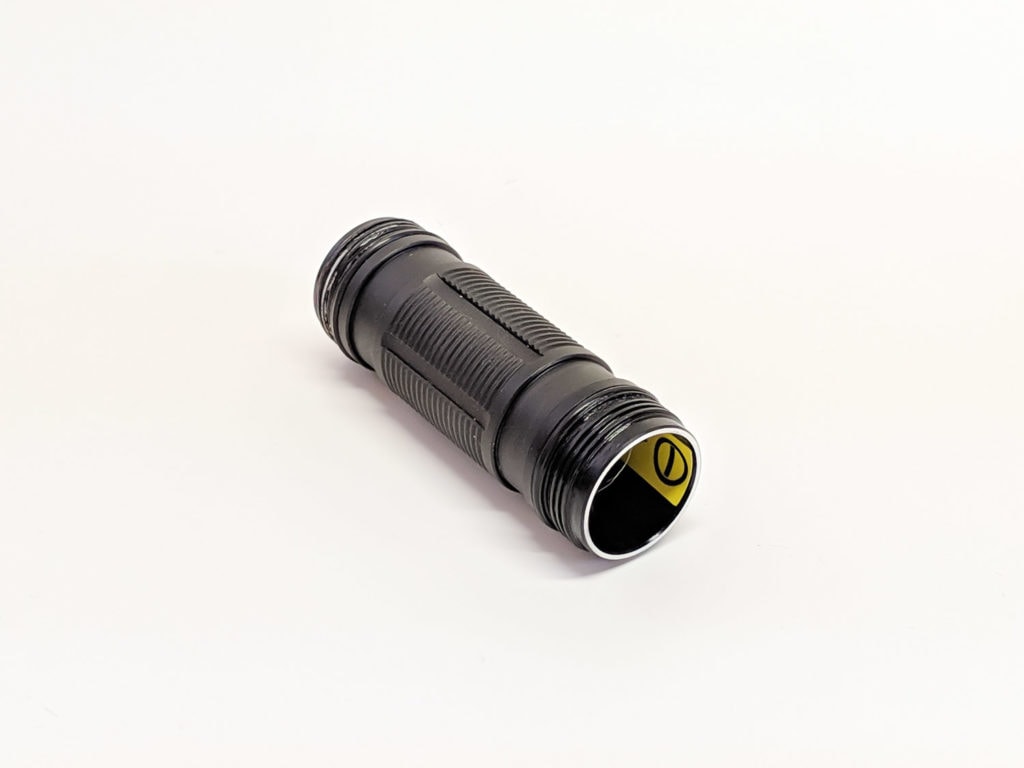
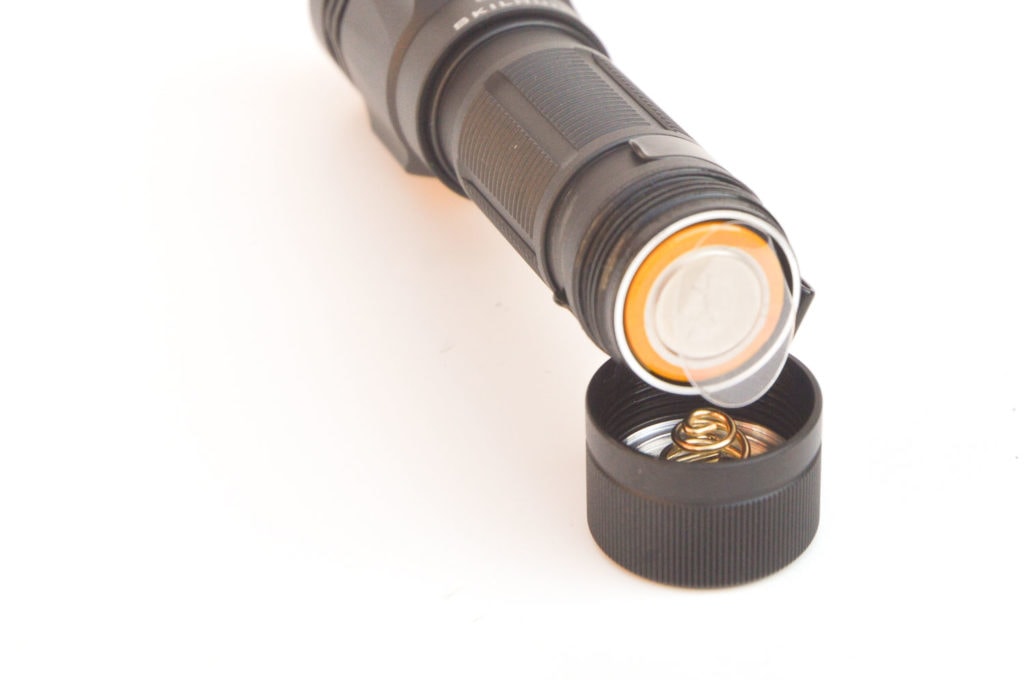
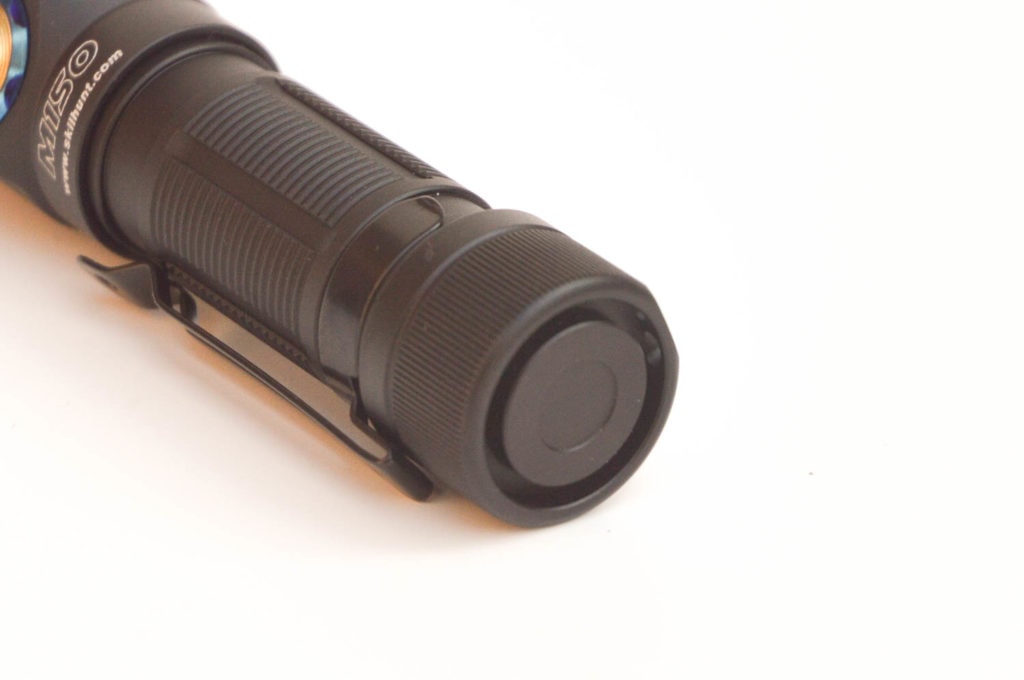
LEDs, Lens, Bezel and Reflector
- LED: Cree XPL2 HD Cool white
- CRI: Unknown
- Stainless steel bezel and switch ring with pvd (Physical Vapour Deposition) and scratch resistant coating
- Reflector with Ultra High dielectric optical coating
- AR coated glass
The Skilhunt M150 comes with a Cool White Cree XPL2 HD LED which is mounted on a copper DTP board combined with a traditional reflector. It is made of durable vacuum plated aluminium. The beam is surprisingly good, since it provides a good combination of throw and flood.
The lens is made of AR coated glass and the bezel (which I really like because it is non-crenelated), is a nice blue PVD coated Stainless steel type, the same can be said for the switch ring. This combined with the magnetic charging port (which also is assembled very well), plus the blue Stainless Steel details gives the Skilhunt M150 a classy look.
The beam is as we can expect for a typical reflector type. It has a nice and even white hotspot due to its orange peel reflector and also has enough spill.
The tint of the LED is cool white, and due to the fact it is an XPL2 LED the hotspot is nice and even but the corona has the typical yellow/greenish spill. As a side effect for this LED type, it could have been eliminated by choosing a Luminus SST20 LED for example.
Opening the head is very easy by unscrewing the PVD coated stainless steel bezel. The DTP board (direct thermal path) does seem to have an unusual rectangular shape instead of the common round type board. This makes replacing the LED an extra challenge, because you have to reflow the emitter onto the custom DTP board.
The sideswitch has a small LED that works as a location indicator, where it will light up every second to find the light in the dark. At the same time it is used as a power capacity indicator.
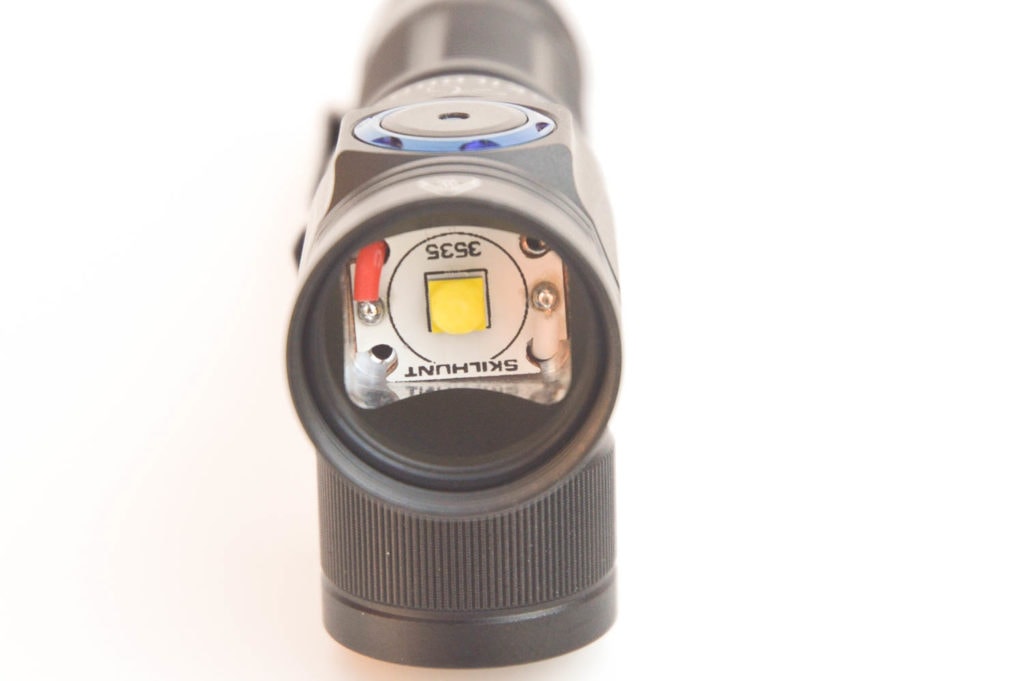
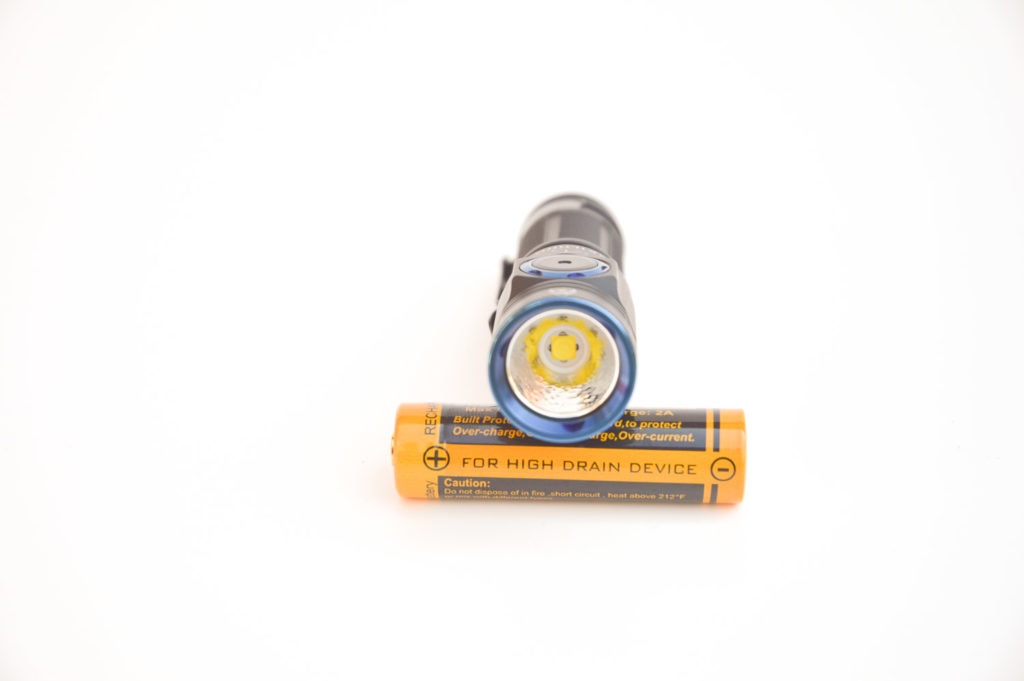
Dimensions:
- Head diameter: 21,0mm / 0,82”
- Body diameter: 18,0mm / 0,71”
Weight:
- Empty: 40 grams
- With cells: 60 grams
From left to right: Acebeam TK16, Jetbeam, Skilhunt M150, Reylight, Reylight, Jaxman E2L, BLF Q8
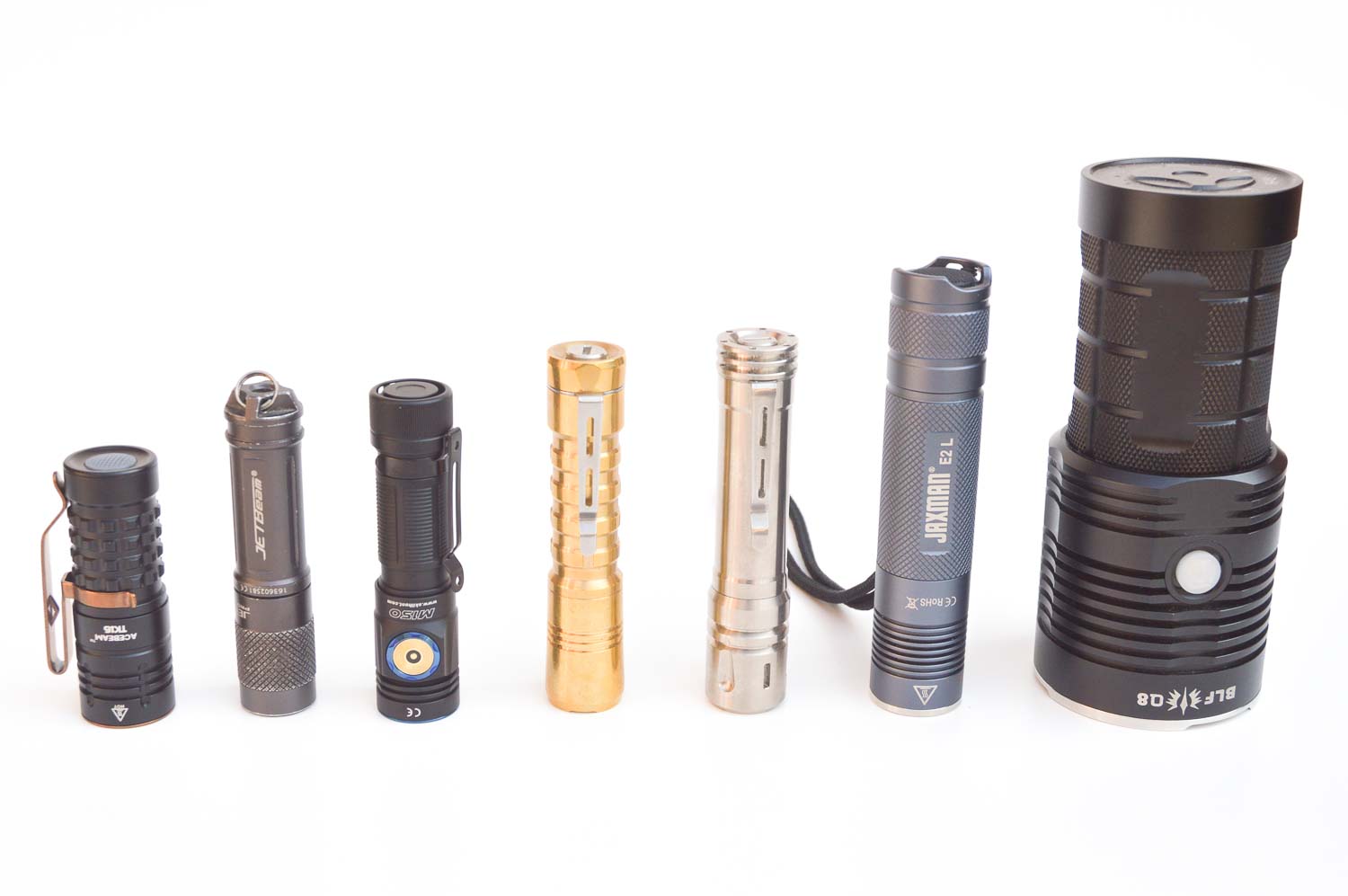
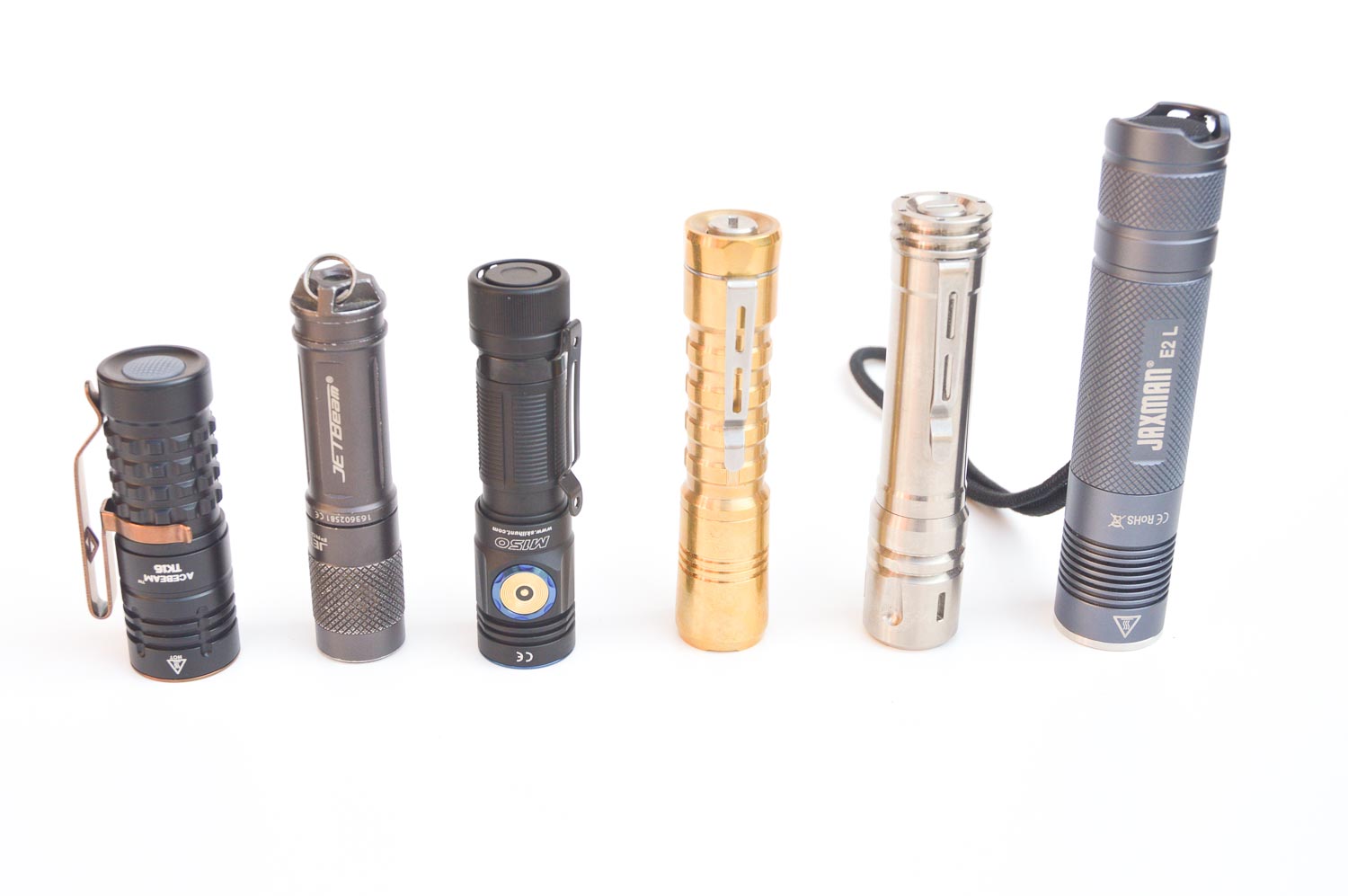
User Interface:
The light distinguishes 4 clicks:
- 1: standard (short click)
- 2: Quick double click
- 3: quick triple click
- 4: 0,5 sec. click
The UI varies between mode group A and mode group B.
Mode group select
The light features 2 mode groups, which can be selected by holding the sideswitch (from OFF) for 5 seconds. The light will indicate that another mode is selected by flashing 3 blinks. This is the same for mode group A as well as for mode group B. It is unclear which mode group is selected, there is no indication for mode group A or mode group B you have to find out for yourself which group is active.
Mode group A:
From off:
- Press and Hold: after 0,5 sec, LOW mode will be enabled, after 1,5 sec the light will go into lock mode and switches off, after 5 sec, mode group switch will be toggled.
- Single click: last used memory
- Double click: turbo
- Triple click: strobe
- 4x click: N.A.
From every mode in group A, 0,5 sec click for off.
From on:
- Press and Hold: Light will switch OFF after 0,5 sec.
- Single click: last used memory
- Double click: activates sub level (lower sub mode)
- Triple click: activates strobe mode
Strobes:
- Strobes can be reached in Mode group A, only from the off position. Do this by a fast triple click. Mode group A has three types of strobes, cycle through the modes by a fast double click. When in strobe mode, standard lighting mode can be selected by a single short click.
Mode A and B are both memorized, so it will start where you have left the last time
Mode group B
From off,
- Press and Hold: after 0,5 sec, LOW mode will be enabled, after 1,5 sec the light will go into lock mode and switches off, after 5 sec, mode group switch will be toggled.
- Single click: last used memory
- Double click: turbo
- Triple click: NA in mode B
- 4x click: N.A.
From on:
- Press and Hold: will automatically cycle through modes (LMHH2TH2HML)
- Single click: last used memory
- Double click: activates strobe mode
- Triple click: NA in mode B
Strobes:
- From every mode, each doubleclick will go to strobe.
(There’s only 1 strobe in group B) to leave strobe mode and return to standard lighting mode, use fast double click.
From every mode in group B, single click (short click) for off.
Mode A and B both are memorized, so it will start in the mode you have used the last time
Mode spacing In group B
Spacing between low and medium is not very well chosen in my opinion. Low mode is okay, but medium is too bright in my opinion. It doesn’t look linear and the lightmeter confirms that there’s a large gap in between the modes. Personally I think the gap between low and medium is too large.
Lock out
- Press the switch (from off) for 1.5 sec. This will also activate location indicator, where the red LED in the sideswitch will blink every second.
Power indicator
- Every time the light is switched on, the LED on the sideswitch will indicate for 5 sec the remaining battery power.
- Constant blue = 100 ~80%
- Constant Red = 50~20%
- Red indicator flashes every 2 sec. = < 3,0 V
- While charging, the red indicator light will be lit continuously. When the light turns blue continuously, the battery is fully charged.
Modes: depending on group A or B
- A= 8 output levels and 3 strobes L1, L2, M1,M2,H1,H2,T1,T2
- B= 5 outpt levels & 1 strobe (L, M, H1, H2,T)
Mode memory:
- The light features mode memory, by switching on the light it always goes to the last used level.
Low voltage warning:
- The light features Low voltage warning, the indicator LED on the sideswitch will blink 3 times every 2 seconds whenever the battery is below 3,0V.
Strobe/blinkies
- The light has different strobes, 3 strobes in group A, one strobe in group B
PWM
- I could not detect any PWM. Skilhunt claims the driver is designed to deliver a constant current, which is good news, since that means no PWM at all.
Batteries and charging:
The Skilhunt M150 comes with a magnetic charging port which makes it very easy to charge. The charging cable has a USB A connection which fits most regular cellular phone chargers. These are widely available since everyone has to charge mobile devices nowadays. Skilhunt states the M150 is waterproof as well but I haven’t really tested this. The only downside is the proprietary Skilhunt cable, which makes it easy to lose and not really easy to get a replacement.
The Skilhunt 14500 cell performs very well. I tested the M150 with other cells and I couldn’t notice any obvious differences by eye, nor did I see any noticable differences when measuring light output with a lux meter. Also I’ve been using a regular AA battery just for testing purposes, and it works perfectly well on any regular AA cell. Skilhunt claims a working voltage of 0.8V ~ 4.2V so practically every cell should work.
Nevertheless, all testing is done with the delivered skilhunt battery, because it shipped with the light so most people who buy the M150 will use this battery.
Another benefit of the 14500 battery is that it can deliver a higher output than a regular AA battery.
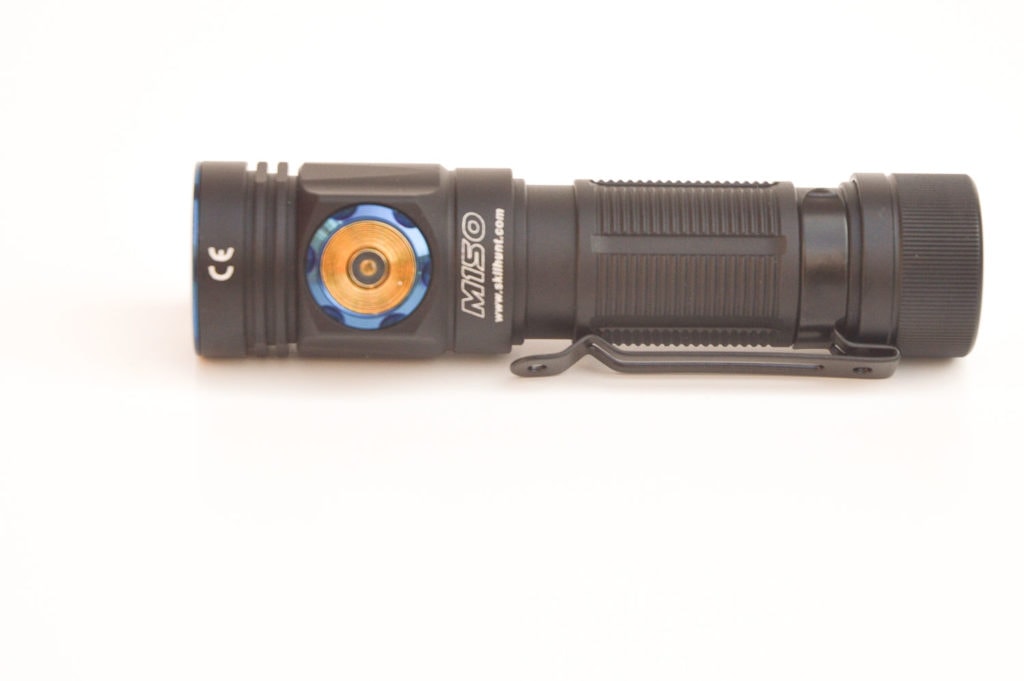
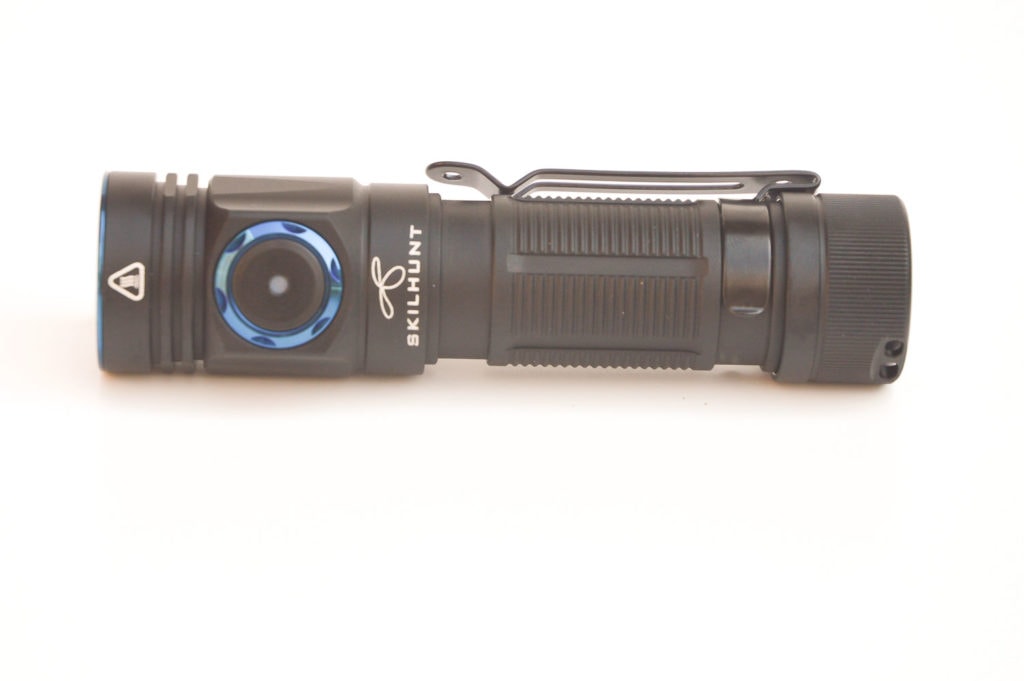
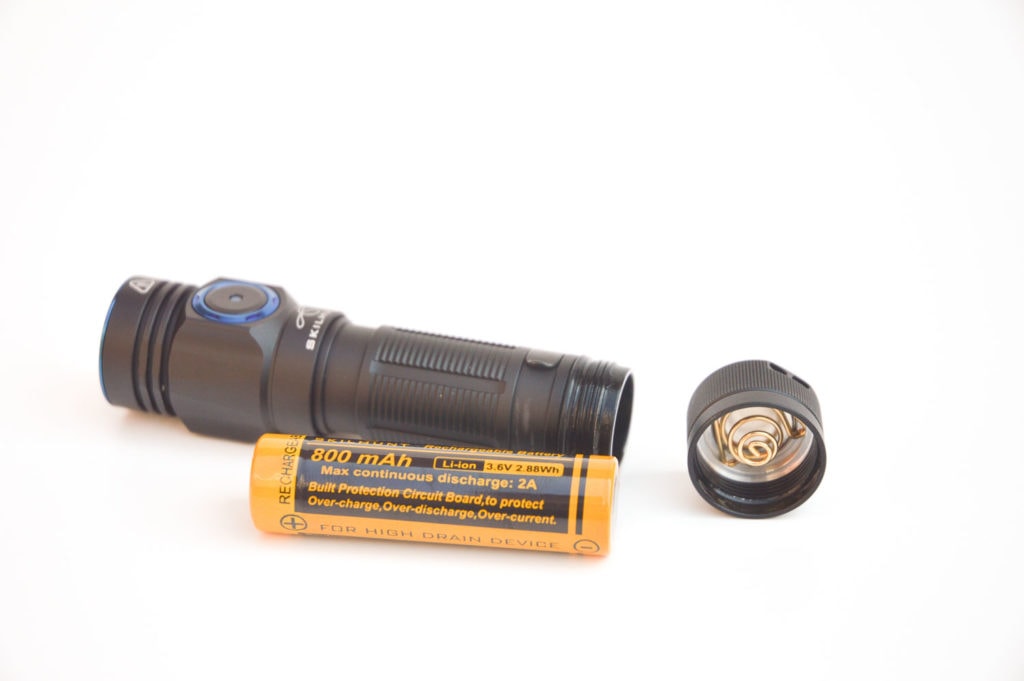
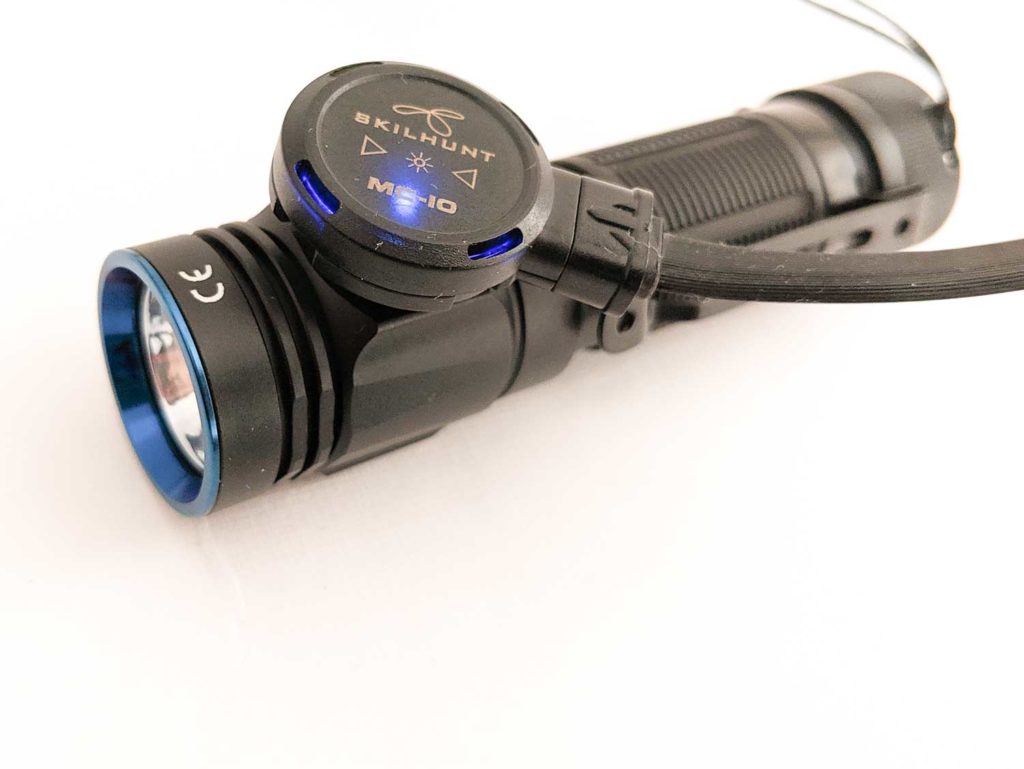
Performance:
Lux readings were taken with the UNI-T UT383S Lux Meter, temperature readings are recorded with an infrared, Non contact thermometer, type Benetech GM-320. Current readings are done with A HGL 3200 Digital MultiMeter.
Amp measurement
- Mode A (4 modes) on 14500 cell
- L1=0.012 No reading
- L2=0.04 A, No reading
- M1=0.16 A, 60 Lm
- M2=0.1A, 13,5 Lm
- H1=0.92 A, 323 Lm
- H2=0.45 A, 182 Lm
- T1=1.3 A, 390 Lm
- T2=1.0A, 290 Lm
Mode B
- L1=0,02 A, No reading
- M1=0,16 A, = 60 Lm
- H2=0,45 A, = 182 Lm
- H1=0,92 A, = 290 Lm
- T1=1,25 A, = 390 Lm
Runtime:
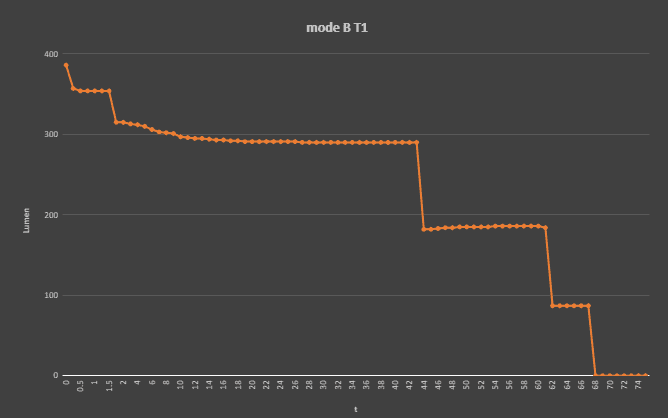
In the test I have used the original Skilhunt battery, fresh off the charger. Note, for the results a deviation of +- 10% should be taken into account since I am using an integrating Lumen tube which is not officially calibrated, it is calibrated against lights with a known Lumen output.
Skilhunt claims a runtime of 1minute on turbo 1, 30min on T2 and 60minutes on H1. I wasn’t able to achieve the claimed runtimes and no matter how hard I’ve tried, I could not achieve the claimed Lumen output on Turbo as well. It is advertised as max 750 Lm, but unfortunately I could not reach that with all fresh charged cells i have used. (skilhunt 800 mAh 14500 cell, Keeppower 14500 cell)
I have contacted Skilhunt for this, they advised me to clean all the contacts and try it again, unfortunately without success. After the 3rd attempt which gave me exactly the same lumen readings, I have placed the cell i had just freshly charged and used for 5 minutes on T1 with the M150 to verify earlier tests, into a jetbeam Jet-1 MK which is claimed 480 Lm on High, and i read 489 @ startup and the light still gave me 430 Lm after 2 minutes, on which point the light was fairly hot, which never happened with the M150 , which gave me max about 400 Lm. It seems the output on T1 on this particular light is lacking performance.
Throw numbers:
- The Skilhunt M150 is claimed for a throw of 110m and 3000 Cd,
- The results I have measured @5 m 77 Lux, which equals 1925 Cd
Beamshots:
Beamshots are done indoors on a 100% white wall, from approximately 1m distance.
From Left to right; Jaxman E2L triple 219C with Nichia 219C 4000K LED’s, vs Convoy S2+ with an XPL-HI LED in a 4B tint (+- 4500 ~ 4700K) and a smooth reflector vs the Skilhunt M150.
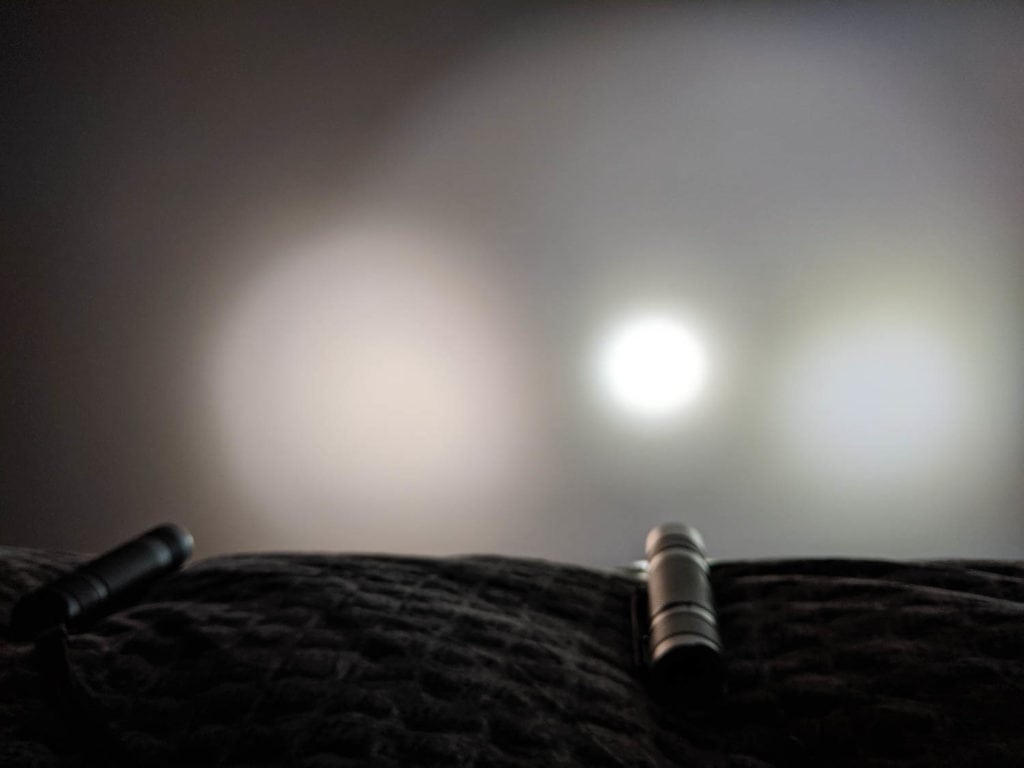
Disclaimer: the flashlight was provided for review by Skilhunt
Overall conclusion
Pros:
- Very pocketable
- Excellent quality, design and finish
- mechanical and electronic lockout possible
- comes with 14500 cell
- Useful magnetic tailcap
Cons
- UI not great
- XPL2 corona
- Not able to achieve the claimed runtimes and performance.
- Threadlocker, not easy to mod

Overall Rating: Ok ★★★☆☆
With the M150, Skilhunt has released a very nice pocketable EDC’able light with many features. It is designed very well, built very well, looks classy and the magnetic charging port is nice to have, since it will eliminate the need for an external charger. The magnetic tailcap is very useful, the whole package is very complete, well-done Skilhunt! As much as I like this light, unfortunately, there are also some downsides. One of the downsides is, I still need to learn to live with the UI in Mode A. I would have preferred another mode set, with the possibility to go back to any previous mode instead of several sub-level modes and the up and down mode sequence which makes it very hard to quickly find out which mode you are actually using. Together with the suboptimal tint shift of the Cree XPL2 LED (the yellowish/greenish corona), the inability to reach the claimed output and runtimes make that for all the positive sides, some points have to be subtracted for the negative sides and therefore I rate it 3 stars out of five.
Skilhunt M150 for sale
(the linked ones are for the Skilhunt M150 v3. See its review for all new measurements.
Get 6% discount at Skilhunt by using the following discount code: blf06
1lumen selects and reviews products personally. We may earn affiliate commissions through our links, which help support our testing.